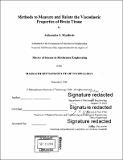Methods to measure and relate the viscoelastic properties of brain tissue
Author(s)
Mijailovic, Aleksandar S
DownloadFull printable version (9.177Mb)
Other Contributors
Massachusetts Institute of Technology. Department of Mechanical Engineering.
Advisor
Krystyn J. Van Vliet.
Terms of use
Metadata
Show full item recordAbstract
Measurement of brain tissue elastic and viscoelastic properties is of interest for modeling traumatic brain injury, understanding and creating new biomarkers for brain diseases, improving neurosurgery procedures and development of tissue surrogate materials for evaluating protective strategies (e.g., helmets). However, accurate measurement of mechanical properties of brain tissue is challenging due to the high compliance and complex mechanical behavior of this tissue, including nonlinear viscoelastic behavior, poroelastic deformation, and failure mechanisms. Thus, reported measurements of the elastic and viscoelastic moduli of brain tissue vary by several orders of magnitude. This thesis highlights three mechanical characterization techniques for brain tissue: rheology, cavitation rheology, and impact indentation. Rheology is used to measure the shear storage and loss moduli of brain tissue in (1) healthy and tuberous sclerosis mouse brain and (2) healthy porcine brain. Next, cavitation rheology - a technique used to measure the elastic modulus of compliant polymers and tissues - is implemented for the first time in porcine brain tissue. Finally, a new analytical model and analysis procedure are developed for impact indentation, a novel mechanical characterization technique that was used to measure the impact response of murine and porcine brain tissue and brain tissue simulant polymers. This new analytical model allows for measurement of viscoelastic moduli via impact indentation experimental data, and it directly relates viscoelastic moduli to impact indentation output parameters of quality factor, energy dissipation capacity, and maximum penetration depth without the need for finite element simulation.
Description
Thesis: S.M., Massachusetts Institute of Technology, Department of Mechanical Engineering, 2016. Cataloged from PDF version of thesis. Includes bibliographical references (pages 71-75).
Date issued
2016Department
Massachusetts Institute of Technology. Department of Mechanical EngineeringPublisher
Massachusetts Institute of Technology
Keywords
Mechanical Engineering.